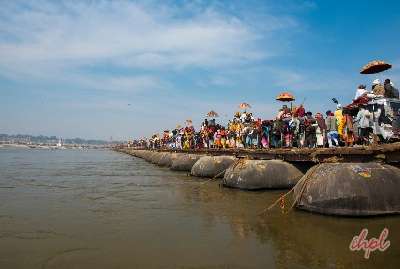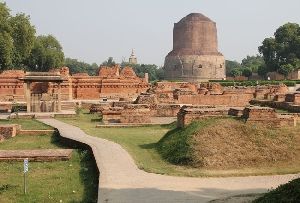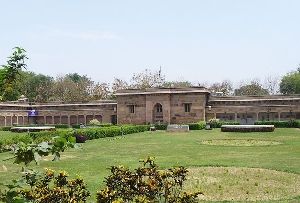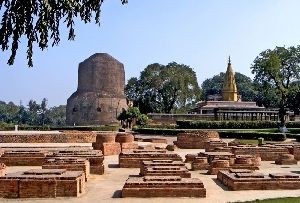A renowned pilgrimage and tourist destination in India, Sarnath is located at a distance of 8 km from Varanasi in the state of Uttar Pradesh in northern India. Revered as the site where Lord Buddha had delivered his first sermon after attaining enlightenment, Sarnath is one of the four most important Buddhist pilgrimage destinations in India. There are several tourist attractions in Sarnath that are worth visiting.
According to historians, Gautam Buddha preached his first discourse at the Deer Park in Sarnath. Every Buddhist seeks to visit Sarnath at least once in his lifetime. Emperor Ashoka, who took several measures to spread the teachings of Buddhism across his vast empire, is believed to have visited Sarnath in 234 B.C. and erected a stupa here. Several Budhist structures were constructed at Sarnath between the 3rd century B.C. and 11th century A.D. Tourist attractions in Sarnath Uttar Pradesh comprise the most extensive ruins amongst holy sites on the Buddhist trail. Sarnath Tourist Attractions mainly include several stupas, excavated ruins of age old monasteries, the deer park besides various other interesting sites.
There are several 20th century Buddhsit Temples in Sarnath, constructed and maintained by monks from Tibet, China and Japan. But the most prominent among the tourist attractions in Sarnath Uttar Pradesh is the Deer Park, which has ruins of several monuments. It is at this deer park of Sarnath that the Buddha preached his first discourse after enlightenment. Inside the park is the ‘Dhamek Stupa’ – built during 5th-6th century to commemorate the spot where the Buddha gave his first sermon. Surrounding this stupa are the ruins of a monastery. The ‘Chaukhandi Stupa’ on the way to the Deer Park marks the spot where the Buddha had met the five ascetics whom he later preached his first sermon.
Also famous among the tourist attractions in Sarnath Uttar Pradesh is the ruined Dharmarajika Stupa, believed to have been built by Emperor Ashoka during the 3rd century B.C. The stupa was enlarged five times by different empires spanning over different centuries. Near the stupa there used to be the glistening ‘Ashokan Pillar’, unearthed in 1905. The pillar is topped by an exquisite capital showing four seated lions facing outwards on a bell shaped base with lotus leaves. The pillar had a round shaped abacus with an elephant, a horse and a bull. The lion capital is now the National Emblem of India.
Other places of interest in Sarnath in Uttar Pradesh include the Sarnath Museum that exhibits a rich collection of Buddhist sculptures, heralded among the finest embodiments of Buddhist art.
The main shrine (vihara) at Sarnath is the ‘Mulagandhakuti Vihara’, a 110 feet high tower, believed to have been the hut where the Buddha used to stay during his trips to Sarnath. Buddhist services are conducted here. The blue-stone Buddha Walk and a small lake at the edge of the park bordered by the zoo are also among the tourist attractions in Sarnath Uttar Pradesh.
Buddha Purnima – Sarnath’s annual festival commemorating the birth of the Buddha is also an event that draws numerous devotees and tourists to embark on tour to Sarnath in Uttar Pradesh.
Check out Uttar Pradesh Tour Packages, Varanasi Tour Packages












